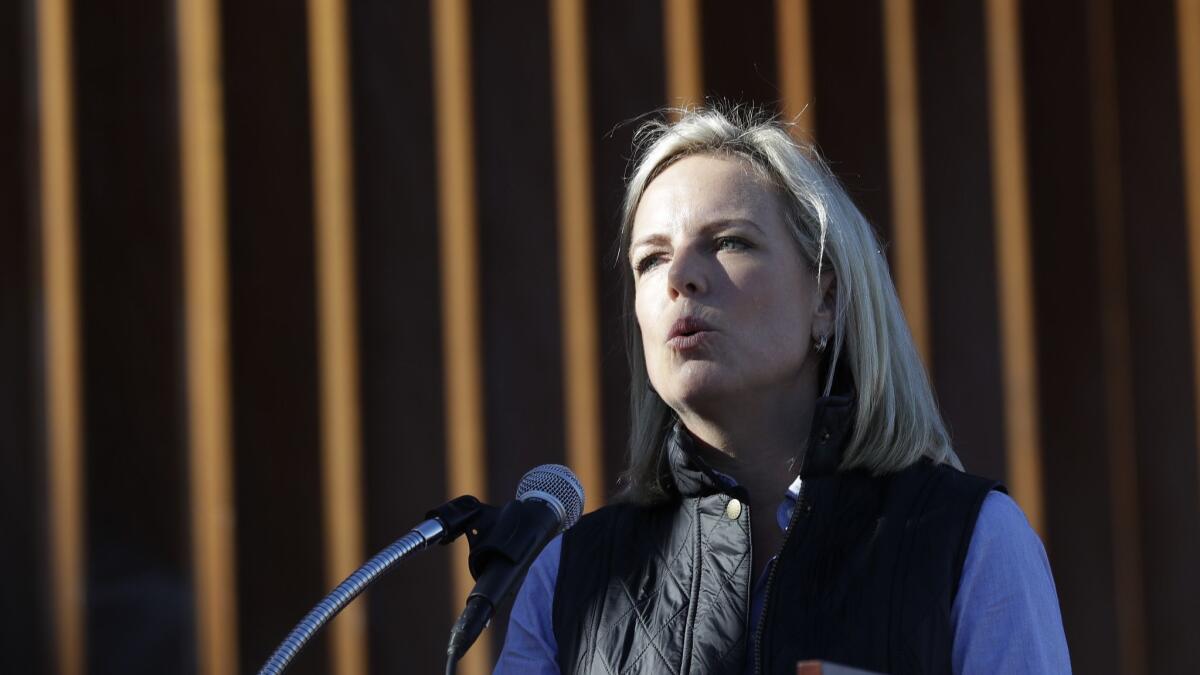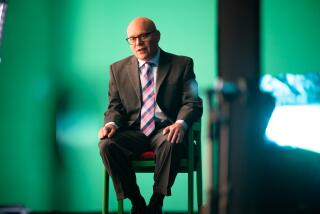Kirstjen Nielsen, Homeland Security chief, resigns after rocky tenure

Reporting from Washington — Secretary of Homeland Security Kirstjen Nielsen, who defended the separation of thousands of migrant children from their families on the southern border, carried out the most sweeping changes to U.S. asylum policy in decades, and saw two Guatemalan children die in her agency’s custody, resigned Sunday.
President Trump announced the departure in a tweet, after meeting with Nielsen at the White House. He briefly thanked Nielsen for her service and said that Kevin McAleenan, the head of the U.S. Customs and Border Protection agency, would become acting secretary.
In a resignation letter, Nielsen said she had “worked tirelessly to advance the goals and missions of the department,” but she had “determined that it is the right time for me to step aside.” She did not detail any policy disagreements with Trump.
Read Nielsen’s resignation letter »
Her departure, however, came just two days after Trump blindsided Homeland Security officials by withdrawing the nomination of a career official, Ronald D. Vitiello, to head Immigration and Customs Enforcement, the Homeland Security agency that arrests and deports people who are in the U.S. illegally.
Trump said at the time that he wanted to go “in a tougher direction.” The move was widely interpreted as an effort by Trump’s senior policy advisor Stephen Miller, an architect of the administration’s hard-line immigration policies, to reshape the agency.
Nielsen and others reportedly were shocked when Vitiello’s nomination was abruptly pulled late Thursday night. Vitiello had been scheduled to accompany Trump on a trip to the border in Southern California on Friday. Amid the confusion, Senate and White House aides thought for a time the notification of the withdrawal had been sent in error.
On Friday, Nielsen met with the president in Calexico after returning early from a planned week of security meetings in Europe. As Trump said during a roundtable meeting that the United States is “full” and “closed” to the near-record numbers of asylum seekers and Central American families arriving, Nielsen sat several chairs away and did not interact with him often.
Nielsen’s departure will soon leave Trump’s Cabinet with only three women — Betsy DeVos at the Education Department, Elaine Chao at Transportation and Gina Haspel as head of the CIA — out of 23 positions. That would be the smallest share of women in Cabinet-level positions since George H.W. Bush’s administration. Linda McMahon, the head of the Small Business Administration, announced recently that she will leave this month to take a high-level position with a pro-Trump campaign committee.
Homeland Security will join a lengthening list of agencies headed by acting directors. The Pentagon and the Interior Department also have acting chiefs, and Mick Mulvaney is the acting White House chief of staff. In the case of Homeland Security, legal experts said that Trump’s designation of McAleenan to head the agency may not comply with the law, which designates another official to take over in the absence of a Senate-confirmed secretary.
Democrats in Congress responded quickly to news of Nielsen resignation.
“We cannot allow her to serve as a scapegoat for the situation at the border or the administration’s failure,” said Rep. Bennie Thompson (D-Miss.), chairman of the House Homeland Security Committee. “Let me be clear, President Trump is to blame for making the situation at the border worse.”
Senate Minority Leader Charles E. Schumer (D-N.Y.) said, “When even the most radical voices in the administration aren’t radical enough for President Trump, you know he’s completely lost touch with the American people.”
An administration official who was not authorized to speak on the record said that Nielsen had known Trump was not happy with her, and that she’d been on “borrowed time” since the departure of her predecessor, John F. Kelly, the former White House chief of staff. The official said she’d been scapegoated for the failure of the administration’s policies to deter migration.
Nielsen was responsible for implementing one of Trump’s most controversial initiatives: splitting up thousands of parents and children who crossed the southern border and holding them apart.
She gave a full-throated defense of the “zero tolerance” policy for illegal border crossings in early 2018 that resulted in the family separations, though some affected migrants crossed legally. Yet she has continued to insist there was no official policy for separating families.
“I’m not a liar,” she said in a tense congressional hearing in December. “We’ve never had a policy for family separation.”
Nielsen endured months of humiliations to hang onto her job, but lost out anyway »
Federal courts later blocked the separations, and Trump formally ended the practice with an executive order. Since then, Homeland Security and other U.S. officials have struggled to reunite separated children with their relatives by court-ordered deadlines, while some parents were deported without their children.
In January, inspectors for the agency that oversees the care of children in federal custody reported that the Trump administration probably separated thousands more children than previously thought, starting well before the “zero tolerance” policy was officially announced in spring of 2018.
Late Friday, the administration said in court filings it could take up to two years to locate and identify potentially thousands more children separated from family at the border.
Nielsen also took heavy criticism after a 7-year-old girl and then an 8-year-old boy, both from Guatemala, died while in Border Patrol custody within three weeks in December.
After the second child died on Christmas Eve, Nielsen decried the tragedy in a lengthy statement, saying that “the death of a child in government custody is deeply concerning and heartbreaking” and announcing efforts to provide better medical care along the border.
But she blamed the children’s parents, Congress, federal judges and others, rather than accept responsibility, though Customs and Border Protection operations and the Border Patrol are under Homeland Security.
Nielsen struggled to balance Trump’s mercurial, sometimes unrealistic demands on immigration and her responsibilities as head of one of the largest departments in the federal government.
She always publicly defended Trump’s immigration crackdown, but the president at times made no secret of his displeasure after she took office in December 2017.
Trump was known to belittle Nielsen and berate her in Cabinet meetings, blaming his Homeland Security secretary for what he viewed as a failure to stop border crossings and nearly leading her to resign or him to fire her several times.
Nielsen, 46, was a close ally of Kelly, who also saw his relationship with Trump fray badly. Nielsen joined the Trump administration in early 2017 as chief of staff to Kelly, and when the former Marine general moved to the White House, she followed as his deputy.
A month later, in October 2017, Trump nominated Nielsen to head Homeland Security. The Senate confirmed her by a vote of 62 to 37.
As head of Homeland Security, Nielsen has been adamant that there is a “humanitarian and security crisis” at the border, though illegal immigration is well below the levels seen from the 1980s to mid-2000s. Apprehensions, the most common measure of illegal immigration, fell dramatically in Trump’s first year in office, but he has been frustrated by a sharp increase since then in minors and families from Central America seeking asylum in the United States.
Although a number of Trump’s immigration policies have been blocked by the courts, the most sweeping change, implemented under Nielsen, remains in effect: forcing asylum seekers to wait in Mexico while their cases are adjudicated in the United States.
Beyond immigration and border security, Nielsen, like Kelly, publicly backed a number of Trump’s more controversial pronouncements, such as his claim that “both sides were to blame” after deadly violence broke out between white supremacists and counter-protesters in Charlottesville, Va.
“It’s not that one side is right, one side is wrong. Anybody that is advocating violence, we need to work to mitigate,” she said at the Aspen Security Forum in July 2018.
Nielsen was widely mocked for her testimony to a Senate committee on Jan. 16, 2018, that focused, in part, on whether Trump had described Africa and Haiti in crude, disparaging terms.
After Sen. Patrick J. Leahy (D-Vt.) asked her if Norway was a predominantly white country. Nielsen responded, “I actually do not know that, sir.”
“But I imagine that is the case,” she added.
Staff writer Eli Stokols in Washington contributed to this report.
More to Read
Get the L.A. Times Politics newsletter
Deeply reported insights into legislation, politics and policy from Sacramento, Washington and beyond. In your inbox three times per week.
You may occasionally receive promotional content from the Los Angeles Times.












